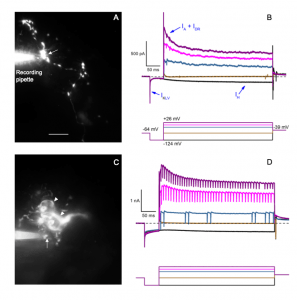Antonia (Toni) González Garrido
Vestibular activity drives a set of reflexes that ensure gaze and head position. There are 3 kinds of afferent innervation in the vestibular system, bouton-only, calyx-only and dimorphic (combining the previous two). Bouton-only terminals are regular, calyx-only are irregular and dimorphic could present both firing patterns (Goldberg et al., 1990; Lysakowski & Goldberg, 1997).
The in vitro semi-intact preparation of the mouse utricle conserves the neuroepithelium functional and complete (sensory cells and primary afferent innervation), allowing the study of primary vestibular afferent synapse mechanisms (Songer & Eatock, 2013). Type II hair cells in amniote vestibular epithelia synapse with compact bouton terminals of primary afferent neurons which either contact type II hair cells alone (bouton-only afferents) or also form calyceal endings on type I hair cells (dimorphic afferents). There is no data available about membrane properties (passive characteristics and voltage-gated conductances) of these bouton afferent terminals, so the mechanisms underlying this synapse have remained unknown.
Now, we are investigating which voltage-gated conductances are functionally expressed in bouton afferent terminals and how mechanical stimulation drives its activity. The intracellular solution contains a fluorescent dye (Sulforhodamine 101 or Alexa Fluor 594) allowing the identification of the morphology of each recorded afferent terminal (Figure 1A and C). Bouton endings from bouton-only and dimorphic afferents terminals have HCN currents and voltage-gated K+ (Kv) currents that are low voltage, A-type and delayed rectifier type (Figure 1B and D). For dimorphic terminal arbors, it is possible to record non-quantal responses from a bouton ending that were evoked by moving the hair bundle of a type I hair cell innervated by the same afferent (Figure 3).
Electrophysiological recordings combined with documentation of the terminal arbor morphology should yield the distinct contributions of bouton and calyceal synapses to the spontaneous and evoked activity of dimorphic afferents.
Figure 1. Whole-cell recordings from two kinds of bouton afferent terminals. A and C, epifluorescence Z-projections of a bouton-only terminal and a dimorphic terminal, respectively; arrows indicate the recorded bouton and arrow heads points two calyces connected to the dimorphic terminal. B and D, currents recorded from boutons of the bouton-only terminal and a dimorphic terminal (see recording pipette in A and C), voltage stimulus protocols are showed below. Scale bar in A, 10-micrometer; also applies to C.
Figure 2. Left, Schematized transverse section illustrating whole-cell recording from the bouton terminal of a dimorphic afferent (cyan) while deflecting (with the blue probe) the hair bundle of a type I hair cell innervated by the same dimorphic afferent neuron. Right, Non-quantal postsynaptic potentials (Black trace, average of 12 individual trials in gray) evoked by a series of sinusoidal bursts at frequencies incremented from 2 to 100 Hz (dark cyan).
References


